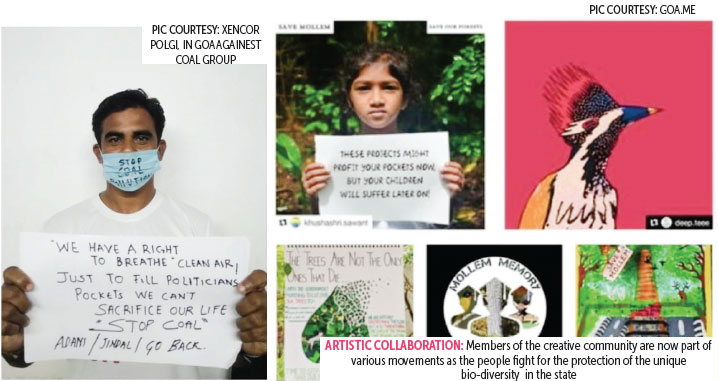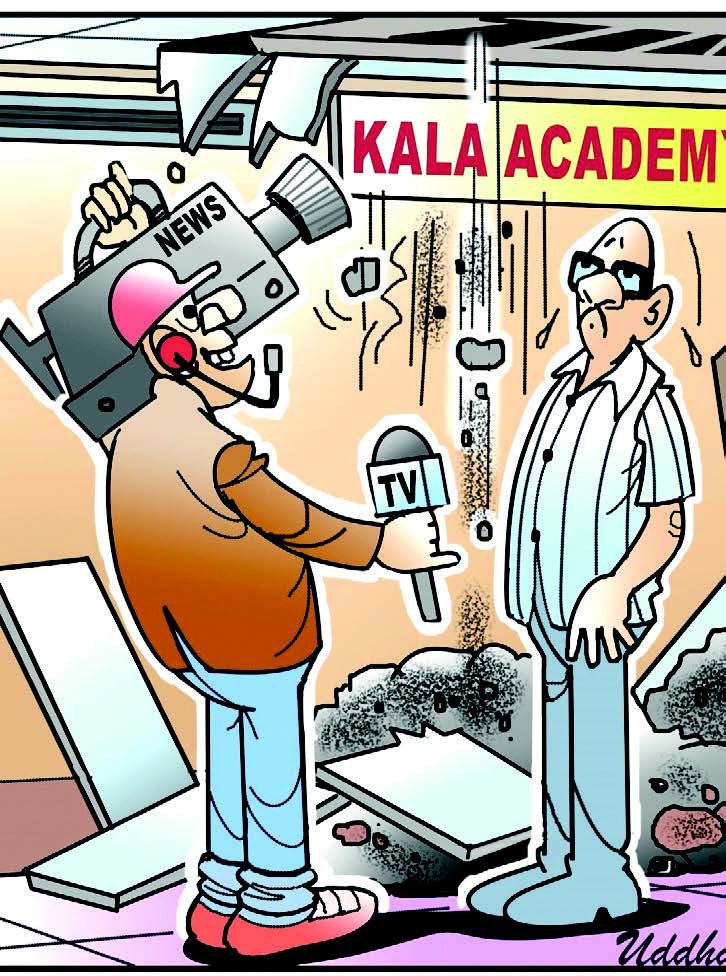
Ajit John
The state has been convulsed by various movements initiated by people in the recent past. These movements commenced after the government decided to go ahead with projects that would cause immeasurable harm to the environment. The projects included the doubling of South Western Railway track on Castlerock-Collem-Margao stretch in South Goa; four-lane national highways over a distance of 13 km in Anmod-Mollem border area, and laying new transmission lines through Bhagwan Mahaveer Wildlife Sanctuary in Mollem. This would mean at least 21,000 trees will need to be cut and 135 acres of forest land needs to be acquired for doubling of the South-Western Railway track. For the four lanes, another 12,097 trees from protected areas will have to be chopped. This will mean a total of 33 hectares of forest and non-forest areas will be diverted for the above project.
Movements around the world bring together strange bedfellows. In many cases, artists, athletes, actors have come together to add their voice and heft to the movement. This has been true in Goa too. The fight to save the trees in the Bhagwan Mahaveer Wildlife Sanctuary has attracted artists, lawyers, and scientists to the fight.
Svabhu Kohli an independent visual storyteller who has been a resident in Goa for eight years said it was the responsibility of artists to ask difficult questions and engage spaces of learning. He said he got involved because having lived in cities around the country he had witnessed the effect of development projects on the ecosystem and how it had wrecked the quality of life. He said “I am in no way against development but it has to be done taking into consideration the ecosystem. The Western Ghats are every important for the country and for Goa. Hurricanes were common on the eastern coast but now they are becoming common on the western coast. This is because of us playing with mother nature.”
Art, he said creates room for imagination and he was part of a group that was curating art created by artists from around the country who are concerned about the project in Mollem. This was helping people understand complex ideas like interconnectivity between nature and man. He signed off by saying artists had to operate in their environment and ask uncomfortable and difficult questions.
Another artist Shrayagi Israni got involved in the protest to save the paddy fields of Taleigao because she felt it was a very just cause. She said her contribution was in the form of banners, t-shirts and placards for the agitation. Israni said people from all walks of life were taking part in protests across Goa. She said artists, tiatrists, young students were participating with great vigour. She pointed out that around forty to fifty artists were part of various movements. The young she said were using digital media very aggressively and were using various forms of communication to spread the message. Sarcasm was a very popular form of spreading the message. It was very popular with the youth and they were working very hard in the movement to save Mollem for example. Photographers were doing pro bono work creating a database for the future. Everyone she said was focussed on ensuring the biodiversity of Goa is saved. The textile designer by training hoped it would all work out fine.
Malaika Mathew Chawla a Zoology and Botany student from the batch of 2015-2018 of Parvatibai Chowgule College of Arts and Science, Margao was one of the signatories in a letter that was sent out by concerned students of that stream to Prakash Javadekar, Minister of Environment, Forest and Climate Change and the members of the National Board of Wildlife. Now studying in Australia, she said it was a letter sent by students concerned about the impending projects in Mollem. She said “Activism lead by students is very important and earlier around 400 medical students had highlighted the dangers that could arise from it. The ongoing pandemic is because of human intervention in wildlife. If the government ignores these concerns then it will mean they are not concerned about Goa. The next generation will pay for this. We used Twitter, Instagram, Facebook to spread information. Videos were uploaded and it has helped. Our future is at stake”.
Cecille Rodrigues and her #RostoGoa campaign jolted the government with her initiatives on the ground. She said it all came from an old hit of Lorna which she used to highlight the poor state of roads in the state. She said “I rewrote the lyrics and essentially said that if you did not improve the roads, I would hit you on your head. It caught the fancy of the people and went viral. I then went ahead and designed a t-shirt with the message and wore it every time I stepped out of the house for eight months. Then just before Liberation day, I walked 15 km between Panjim and Cortalim to highlight the poor state of the roads. We recorded everything and posted it. We started painting speed breakers which got a lot of local support. We painted over 300-speed breakers in three months. Simultaneously we also started a kachra campaign. All this stopped with the lockdown.” Now they are helping out in the community by picking up food from restaurants who have extra at night and delivering it to people who have no food.
They are also started a campaign #Proud to be a Shetkar in an attempt to make farming look good and cool. Photographs and videos are uploaded and yes potholes are being filled. This bit is being done at night.
Digital media and the enthusiasm of the youth and the passion of artists have certainly helped to spread the message. Svabhu Kohli said the Mollem forest was very rich in biodiversity and last year 20 new species were found which was unbelievable. History will not be kind if the people don’t do what needs to be done to protect it and other places in the state.
And it will indeed be kind to al the young and the good at heart to go out there and do what it takes, and do it creatively and skillfully to spread the message. With them, you don’t quite need the public service campaigns done by creative ad agencies. The public, led by the young, is doing great service, using digital technology to the hilt
